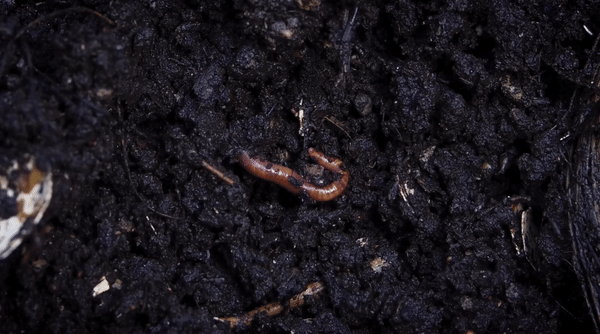HUMUS & SOIL FERTILITY
Why is it so important and how can we build it?
Humus is a dark, loose, and fertile layer in the soil that forms from the breakdown of plant and animal matter. When leaves, dead plants, or other organic materials fall to the ground, they are decomposed by microorganisms like bacteria, fungi, and worms. This process turns the remains into a nutrient-rich substance—humus.
Humus has many valuable properties: it stores nutrients and water, improves soil structure, and helps plants grow healthily. It also captures carbon, contributing to climate protection. In short, humus is like “superfood” for soil, making it fertile and strengthening plants.

Soil Structure
Soil structure, or soil texture, refers to the spatial arrangement of the solid components of soil (sand, silt, clay particles, and humus). The type of arrangement determines the pore volume, i.e., the voids within the soil, and their characteristics (size, depth, continuity). Soil structure has a significant influence on a soil's air, water, and heat balance, as well as root growth. Soil structure is dependent on various factors and can be positively or negatively altered through management practices. Measures to stabilize soil structure, such as the addition of organic matter, cover cropping, and liming, significantly contribute to favorable soil structure. Factors that promote soil structure include the interaction between clay and humus particles, forming what is known as clay-humus complexes, as well as the "living binding" of mineral particles by the root hairs of higher plants, fungal hyphae, bacterial colonies, and soil organisms, particularly earthworms. These factors have positive effects on a site's productivity and nutrient efficiency. The greatest threat to soil structure comes from traffic and cultivation of fields when they are too wet. Excessive fertilizer application, in case of damaged soil structure due to factors like heavy machinery, may alleviate the inhibition of plant growth but cannot fully compensate for it. The assessment of structural damage is best achieved through the use of spade diagnosis or a soil probe, with some practice.
Soil Life and Humus Supply
Although soil life accounts for only about 2 - 5% of the carbon stored in soils, it is the direct cause of nearly all chemical and physical transformations that take place in the soil. Soil life encompasses soil microflora (soil microorganisms) and soil fauna. Soil microflora consists of bacteria, fungi, and algae. They make up about 80% of the total soil life. Soil microorganisms play a crucial role in the carbon, nitrogen, phosphorus, and sulfur cycles, in maintaining stable soil structure, protecting plants from pathogens and diseases, and thereby promoting plant growth. A productive and diverse soil microflora is a prerequisite for fertile soil. Soil fauna ranges from single-celled organisms to vertebrates. Soil organisms like earthworms, millipedes, woodlice, mites, springtails, and insect larvae decompose plant residues such as straw or other crop residues and also enhance the material transformation processes carried out by microflora.
Earthworms are the most important group of animals actively altering soil structure. Through their burrowing activities, they create an extensive network of tunnels that counteract soil compaction, improve oxygen supply, enhance water retention capacity, and increase soil infiltration rates, thus reducing the risk of erosion. Abandoned earthworm burrows serve as preferred pathways for root growth deep into the subsoil and provide habitat for many non-burrowing soil organisms. In addition to organic material, earthworms also ingest mineral components of the soil. In the earthworm's digestive system, stable clay-humus complexes form. The excreted earthworm castings are rich in humus, nutrients, and enzymes compared to the surrounding soil.
Therefore, active soil life plays a key role in soil fertility and efficient fertilization. The humus supply of the soil is crucial since humus serves as the primary food source for soil microorganisms and soil fauna. Numerous experiments confirm a close relationship between soil humus content and the amount of microbial biomass. Furthermore, the importance of humus lies in its complex and interconnected influence on nearly all soil properties and functions. Humus (organic matter in soil) is a complex mixture of organic substances of plant, microbial, and animal origin, found in various stages of decomposition or quality levels. Humus is formed from crop residues, organic fertilizers, dead soil microorganisms, and soil fauna primarily through microbial decomposition. Humus (humus content = organic carbon content Corg x 1.72) has several important functions for the soil and plant growth, including:
Nutrient Storage: Humus provides a slow-release nutrient source for plants. Through the microbial breakdown of humus components, organic-bound elements (carbon, nitrogen, phosphorus, sulfur, oxygen, etc.) are converted into plant-available compounds.
Soil Structure Formation: Humus acts as a binding and stabilizing agent for soil structure by adhering mineral particles together to form pore-rich soil aggregates, known as clay-humus complexes. This positively influences air and water movement in the soil. Consequently, it controls the water and nutrient supply to plant roots, root development, aeration, microbial activity, water-holding capacity, water percolation, and the stability of soil aggregates, as well as soil trafficability and workability. Optimal humus content can reduce potential hazards from soil compaction and erosion.
Water Retention: This property is particularly important in the context of climate change. The stored amount of water can be several times the weight of humus.
Filtering and Buffering: Humus can adsorb cations (calcium, magnesium, potassium, etc.) and anions (phosphate, sulfate, nitrate) important for plant nutrition, making them exchangeable and protecting some of these nutrients from leaching. This process is particularly crucial in sandy soils due to their low clay content. Proteins, a significant component of humus, act as buffers and prevent major pH fluctuations, a critical factor for biochemical processes in the soil. Finally, through various adsorption mechanisms

